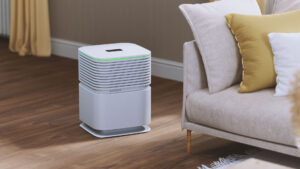Warmer weather brings blooming flowers, fresh breezes, and a surge in outdoor pollutants that can affect your home. What happens outside doesn’t stay outside. From pollen to vehicle emissions, external air plays a major role in determining the air quality indoors.
Understanding how outdoor air impacts your indoor environment is the first step toward improving your living space. Explore how external factors affect indoor air quality and some practical solutions to help you breathe easier.
How Outdoor Air Influences Indoor Air Quality
Outdoor air affects your home environment more than you might realize. Below are the primary ways outdoor air influences indoor air quality:
Pollutant Infiltration
Outdoor pollutants can easily find their way inside, even when windows and doors are closed. The infiltration process allows microscopic particles to accumulate and impact air quality. Outdoor air carries pollutants like pollen, dust, vehicle emissions and industrial byproducts. These particles enter your home through open doors and windows, cracks and HVAC systems. During spring, trees and grasses release pollen that can easily drift inside. This pollen can exacerbate allergies and contribute to poor air quality in your home.
Wildfires and Environmental Events
Major environmental events — like wildfires and industrial emissions — can significantly affect the air you breathe indoors. Smoke from wildfires produces fine particulate matter that can travel long distances. These microscopic particles penetrate homes, worsening respiratory problems and reducing indoor air quality.
The Environmental Protection Agency links exposure to these particulates to heart and lung complications. This is particularly concerning for vulnerable populations, such as children, older adults and those with preexisting conditions.
Urban Pollution and Traffic Emissions
Living in a city often means being exposed to pollution from vehicles and industrial activities. Vehicle emissions — such as nitrogen dioxide and volatile organic compounds (VOCs) — can enter your home through tiny openings. These pollutants can accumulate over time, leading to long-term health issues. Clean air is vital in supporting your physical and mental well-being.
How to Combat Outdoor Pollution

Although you can’t control outdoor air quality, you can take specific actions to reduce its impact inside your home. Below are four practical solutions to protect your indoor environment:
1. Use Indoor Air Quality Products
Investing in specialized products can make a substantial difference in your home’s air quality. These tools help remove pollutants and maintain healthier air:
- Humidifiers: Maintaining proper humidity levels can prevent dry air, which exacerbates respiratory irritation and allows dust particles to remain airborne. Heating or cooling your home can make the air too dry and ventilation from open windows is not enough. Plus, open windows may cause external pollutants to enter your home. Humidifiers can help you achieve the perfect humidity levels to keep your home optimized.
- Airwashers: These devices combine air purification with humidification, offering a comprehensive solution for improving both moisture levels and air cleanliness. A VENTA Airwasher ensures you maintain perfect humidity levels year round and filters your home’s air up to 99.995% of air particles as small as 0.07 micrometers.
- Air purifiers: These devices use high-efficiency particulate arresting (HEPA) filters to capture airborne particles like pollen, dust and pet dander. Air purifiers are especially useful during spring when allergen levels are highest. VENTA air purifiers remove up to 99.97% of invisible particles in your home’s air.
2. Improve Home Ventilation
Proper ventilation is essential for maintaining good indoor air quality. Increase airflow and bring in cleaner air by:
- Using exhaust fans: Ensure that exhaust fans in kitchens and bathrooms are functioning properly to expel stale air and pollutants.
- Sealing entry points: Identify and seal cracks around doors and windows to prevent outdoor air from sneaking in unnoticed.
- Monitoring air quality: Indoor air quality monitors can help you track pollutant levels and determine when ventilation adjustments are needed.
3. Adjust Landscaping to Reduce Pollutants
Your landscaping choices can impact how much outdoor pollution reaches your home. Here are ways to use your yard as a barrier:
- Trim trees regularly: Overgrown trees can trap moisture and organic debris, which leads to mold growth and increased airborne spores. Regular maintenance reduces this risk. Trees and shrubs that are not maintained can also be a breeding ground for pests. So, keep the pollen and pests at bay with routine landscaping.
- Reduce dust movement: In dry areas, use ground cover like mulch or gravel to prevent dust from being kicked up and carried inside. Also, clean away any pods or seeds that may be carried in with foot traffic.
4. Keep Your Home Clean and Maintained
Regular cleaning and maintenance play a major role in keeping pollutants out of your home. Focus on these key tasks:
- Vacuum frequently: Use a vacuum equipped with a HEPA filter to capture small particles that settle on floors and furniture.
- Replace air filters: Change HVAC filters frequently if you live in a high-pollution area.
- Clean entry points: Regularly wipe down surfaces near doors and windows where outdoor pollutants tend to accumulate.
How to Improve Indoor Air Quality in Cities

- Use secondary air purifiers, humidifiers and Airwashers: Consider using additional portable air maintenance equipment in heavily used areas like bedrooms or living rooms to keep your home optimal.
- Limit outdoor air entry during peak times: Keep windows and doors closed during rush hours or when pollution levels are highest.
- Create a green barrier: Planting trees and shrubs can create a natural shield against airborne pollutants. Choose dense, evergreen species for year-round protection.
How to Test Air Quality in Your Home
Regularly testing your home’s air allows you to identify problems early and take corrective action. Here’s how to monitor your indoor environment effectively:
- Use an indoor air quality monitor: These devices measure pollutants like particulate matter, VOCs and humidity levels in real time.
- Schedule professional testing: If you suspect serious pollution, consider hiring a professional to conduct a comprehensive air quality assessment.
Take Charge of Your Indoor Air Quality
The quality of the air you breathe inside your home is directly affected by outdoor conditions, but you don’t have to let external factors dictate your indoor environment. By understanding how pollutants enter your home and taking proactive steps to mitigate their impact, you can create a cleaner, healthier living space.
Whether you invest in humidifiers, airwashers and air purifiers, improve home ventilation or adjust your landscaping, small changes can lead to significant improvements in your indoor air quality. This spring, take control of your home’s air and enjoy a fresher, healthier season.

